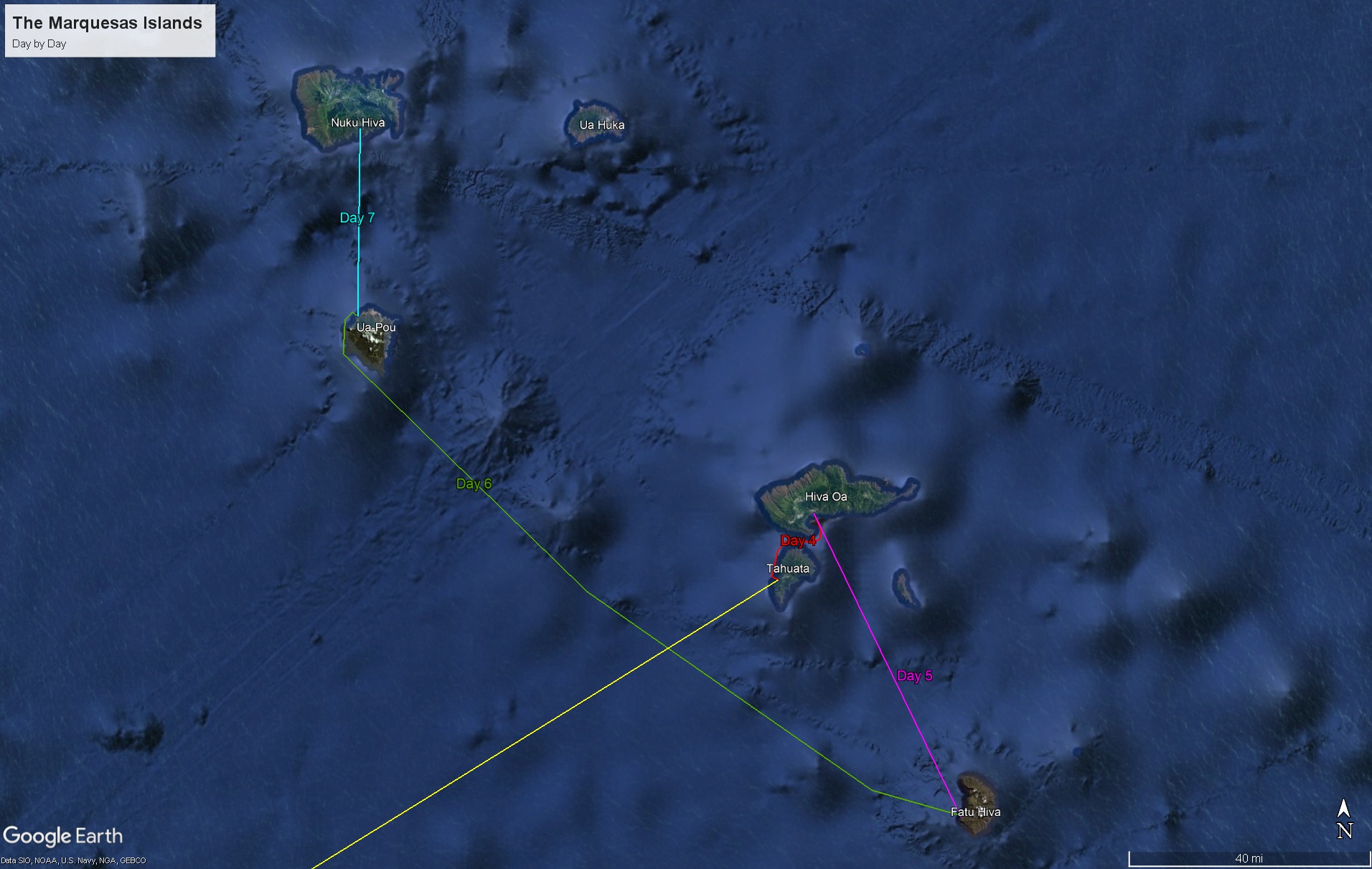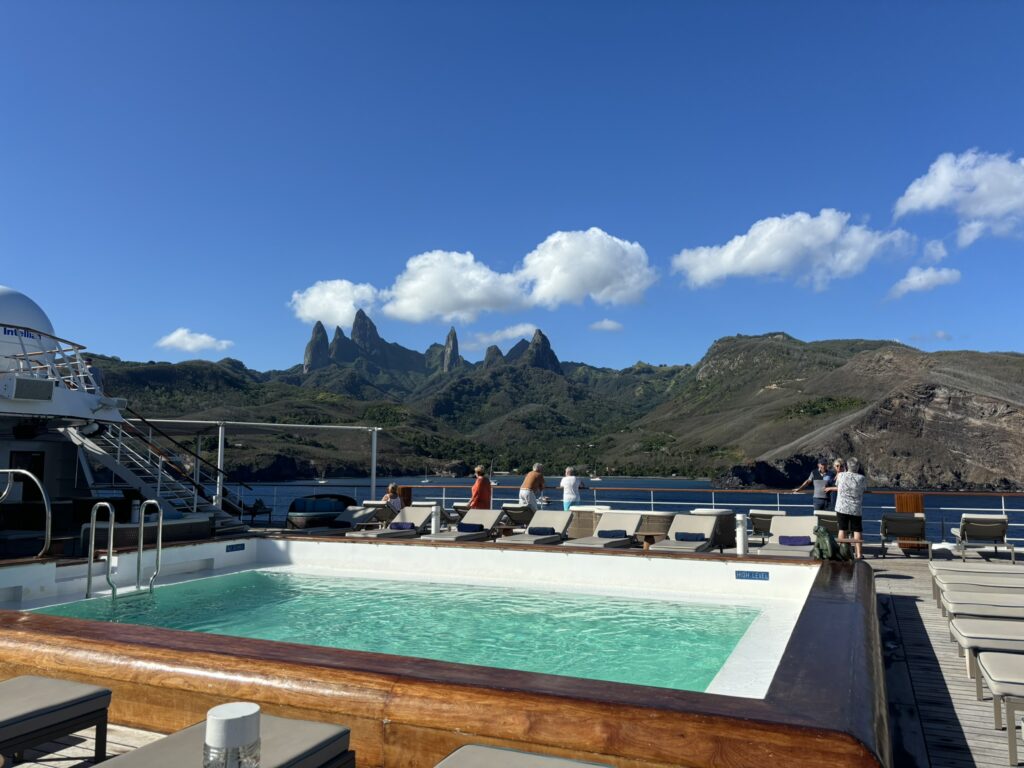Before getting to the Marquesas, there was a sea day so that the Paul Gauguin could make the almost 600 NM journey to Hapatoni, Tahuata in the southern Marquesas.

A sea day is always a great time. While nothing onboard is ever hurried, a sea day is even lower key. In addition to just enjoying the pool, the bars, the dining, a siesta and even a bit of exercise in the fitness center, on this trip, there were two experts on board providing lectures in the Grand Salon. More on those folks later because their lectures were informative, interesting and entertaining.
We spent 5 days in the Marquesas visiting the islands of Tahuata, Hiva Oa, Fatu Hiva, Ua Pou and Nuka Hiva (click to enlarge the image… maybe). In the Marquesan language, the archipelago is called Te Henua Enata, which means “The Land of Men”. The name Marquesas was provided by a pompous Spanish explorer in 1595 as he sailed by.

Due in no small part to the efforts of one of our on-board lecturers, Pascal Erhel, who created a dream and a team, the Marquesas were named a UNESCO World Heritage site in July 2024 for its cultural heritage and value and its abundance and preservation of rare and diverse flora and fauna.
The Marquesas are very different than the Society Islands and the Tuamotu Islands. For one thing they are extremely remote with the average number of tourists visiting each year is rarely above 10,000-15,000 people which is a daily load to Tahiti. Second, the number of inhabitants is significantly less; there are 15 islands, 12 inhabited. Of course, the geology and landforms of all three island groups visited differ significantly.
Geologically all of the Marquesas Islands are volcanic in origin with what one geologist described as “monotonous series of sub-aerial basalt flows…”. There are two locations in the Marquesas that are exceptions to this oversimplification. We visited one of the locations, the island of Ua Po (Marquesan for “pillars”). Ua Pou differs from the other Marquesan Islands in that there is no well-formed caldera and there are 30 or so pillars that dominate the skyline of the island. These features are the result of a difference in the chemistry/mineralogy of the basaltic magma and the temperatures that existed in the subsurface before the magma erupted on the island. For those familiar with Devil’s Tower in Wyoming, the chemistry of the lava in the Marquesas and in Wyoming is very similar and the resulting land feature(s) have similarities.

The Marquesas Island ages decrease from northwest (5.5 Ma at Eiao [off map]) towards southeast (1.1 Ma at Fatu Hiva). The Marquesas shield volcanoes (broad, gently sloping profiles, formed by the eruption of highly fluid lava) experienced collapse of the caldera rims due to thin upper caldera walls and high rates of erosion, which led to the sinking (there is that sinking thing again…)/erosion of half or more of their initial shield volcanos. Most of the current island landforms are made up of a partial outer caldera remnant of the original shield volcano. In the now partial caldera an inner, younger and smaller post-shield volcano is found on most of the islands. There are no coral fringing reefs in the Marquesas Islands for a variety of reasons. The islands experience high winds and surf associated with the winter trade winds that inhibit coral development and are within the El Nino, La Nina zone bringing highly variable (for coral) water temperatures to the island group.
Back to our on-board lecturers. On our sea day, Pascal Ehrel presented the first of three lectures that we would attend, a lecture entitled Motu Haka: A Short History of the Marquesas Islands: Introduction to the Archipelago of Fenua Enata. Motu is a version of the Malayo-Polynesian language family. For rugby players you may recognize the word haka which loosely translated means “dance” but has taken on the meaning “war dance”. The Motu Haka Association is a group of Marquesan and others that have united to gather, safeguard and enhance what of remains of their culture. Fenua Enata as we have seen means “The Land of Men” in referencing the Marquesas Islands. A very interesting and informative lecture which IMHO was made somewhat more entertaining by Pascal’s French accent. Somehow it made the whole event a little more exotic.
The second pair of lectures that we attended were presented by Celine Manet. The first lecture was entitled James Cook – Part 1 (Youth, 1ST Expedition and Return to Tahiti). What a fascinating, intelligent and accomplished guy. Of course, being a captain of a ship back then also entailed being somewhat of a tyrannical despot willing to employ a bit of corporal punishment to keep the swabs in line. But overall, particularly in his younger days, a very interesting fellow and the father of nautical charting and mapping. After the first lecture, I downloaded an Audible biography of Cook to add to the lectures. Again, I think the lectures were somewhat enhanced and made more interesting and tropical with the addition of Ms. Manet’s French accent
Tahuata
We booked an excursion in Tahuata that stopped at several important locations along the coast with ties to the Polynesian culture and with just great views. Excursions in the Marquesas were interesting from the perspective of transportation. The participants were broken into groups of four and transportation was provided by locals in fairly new four-wheel drive pickups. The tour leaders were also local folks who were well versed in the history and of course the culture and were very chatty and obviously proud of their home. Maybe somewhere in these posts, I can incorporate some cultural history as well as current political status. Might just have to go back some day so that there can be follow up blogs!
I tried to add a couple of the islands, but the photo galleries are pretty resource intensive so I will just do each island with short individual posts.
